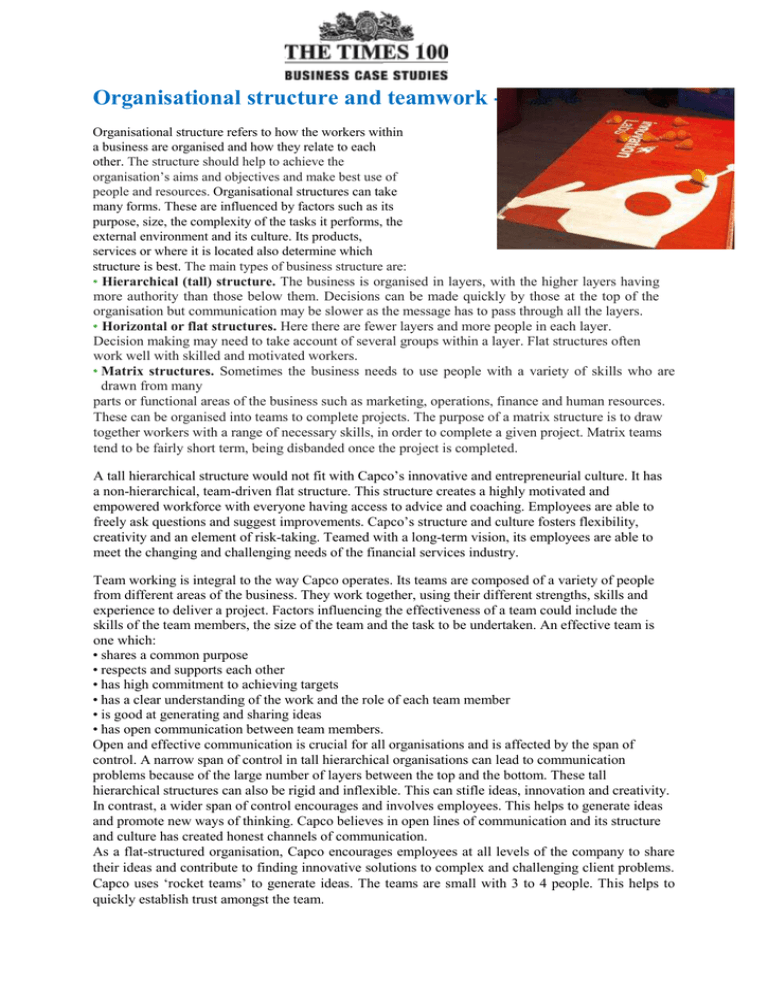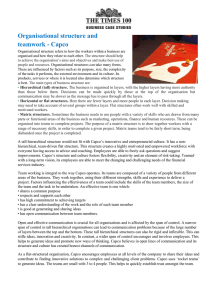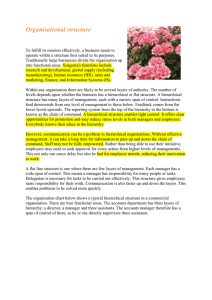Organisational structure and teamwork Case
advertisement

Organisational structure and teamwork - Capco Organisational structure refers to how the workers within a business are organised and how they relate to each other. The structure should help to achieve the organisation’s aims and objectives and make best use of people and resources. Organisational structures can take many forms. These are influenced by factors such as its purpose, size, the complexity of the tasks it performs, the external environment and its culture. Its products, services or where it is located also determine which structure is best. The main types of business structure are: • Hierarchical (tall) structure. The business is organised in layers, with the higher layers having more authority than those below them. Decisions can be made quickly by those at the top of the organisation but communication may be slower as the message has to pass through all the layers. • Horizontal or flat structures. Here there are fewer layers and more people in each layer. Decision making may need to take account of several groups within a layer. Flat structures often work well with skilled and motivated workers. • Matrix structures. Sometimes the business needs to use people with a variety of skills who are drawn from many parts or functional areas of the business such as marketing, operations, finance and human resources. These can be organised into teams to complete projects. The purpose of a matrix structure is to draw together workers with a range of necessary skills, in order to complete a given project. Matrix teams tend to be fairly short term, being disbanded once the project is completed. A tall hierarchical structure would not fit with Capco’s innovative and entrepreneurial culture. It has a non-hierarchical, team-driven flat structure. This structure creates a highly motivated and empowered workforce with everyone having access to advice and coaching. Employees are able to freely ask questions and suggest improvements. Capco’s structure and culture fosters flexibility, creativity and an element of risk-taking. Teamed with a long-term vision, its employees are able to meet the changing and challenging needs of the financial services industry. Team working is integral to the way Capco operates. Its teams are composed of a variety of people from different areas of the business. They work together, using their different strengths, skills and experience to deliver a project. Factors influencing the effectiveness of a team could include the skills of the team members, the size of the team and the task to be undertaken. An effective team is one which: • shares a common purpose • respects and supports each other • has high commitment to achieving targets • has a clear understanding of the work and the role of each team member • is good at generating and sharing ideas • has open communication between team members. Open and effective communication is crucial for all organisations and is affected by the span of control. A narrow span of control in tall hierarchical organisations can lead to communication problems because of the large number of layers between the top and the bottom. These tall hierarchical structures can also be rigid and inflexible. This can stifle ideas, innovation and creativity. In contrast, a wider span of control encourages and involves employees. This helps to generate ideas and promote new ways of thinking. Capco believes in open lines of communication and its structure and culture has created honest channels of communication. As a flat-structured organisation, Capco encourages employees at all levels of the company to share their ideas and contribute to finding innovative solutions to complex and challenging client problems. Capco uses ‘rocket teams’ to generate ideas. The teams are small with 3 to 4 people. This helps to quickly establish trust amongst the team. Questions 1. Define organisation structure. An organisational Structure refers to how workers within a business are organised and how they relate to each other. 2. Describe the purpose of a matrix structure. The purpose of a matrix structure is to draw together workers with a range of necessary skills, in order to complete a given project, these groups are short term being disbanded once the project is completed 3. Analyse the factors that influence the effectiveness of teams in the workplace. In teams you are able to work together in conjunction with the different skills, strength and experience each individual possesses. What makes this team so effective is that they are all working together to achieve one common purpose therefore communication is vital for working in teams. There also has to be a clear understanding of the work and the role of each member in that group. Being able to come up with ideas and sharing them with other members is important in developing an idea into reality. High commitment is essential to the success of the task as everyone needs to put in the effort which makes the outcome worth it in the end. There also has to be a clear understanding of the work and the role of each member in that group. 1. Evaluate whether a flat organisational structure is better than a tall structure for organisations Being able to come up like withCapco. ideas and sharing them with other members is important in developing an idea into reality.High commitment is essential to the success of the task as everyone needs to put A flat organisational structure offers more opportunities for employees to share their thoughts with in the effort which makes the outcome worth it in the end. the business and have overall more freedom to contribute in finding innovative solutions to complex and challenging client problems. Motivation is also an advantage that comes from this organisation has manager delegate work due to larger spans of control. However even though tall organisations have many layers there is more opportunities to get promoted the downside compared to flat organisation is that your voice may not be heard and you could feel less motivated to put any input into the business Task Draw up an organisation chart for a small to medium sized organisation of your choice. When it is completed, answer the following questions: Does the organisation have a tall or flat structure? How many layers are in the hierarchy? Who has the largest span of control, and how big is it? What have you learned? The business that I have chosen is Overclockers, this business specialises in the distribution and building of computers, they sell; various components individual too. Boss/CEO Marketing staff Distributions Manufacturing /building staff IT staff Human Resources Finance staff The organisation is a flat structure, flat structures are usually comprised of skilled people who specialise in a certain field and are vital to the success of the business. When parts are received the workers have to specifically build the PC to the customers’ requirements. The prices of most of these computers fetch for expensive prices due to the cost of parts and the expertise/labour that each worker has to put into building one of these computers whether it be for gaming or business. There are maximum two layers to the business The largest span of control is the boss as he makes the final decisions but the advantage of the flat structure is that it allows for the employees to contribute ideas forward. What have you learned? In today’s activity I have learnt about the different type of organisational structures in a business, two examples would be a tall and flat organisation and the differences between the two. I also learnt about the advantages and disadvantages to each structure.





